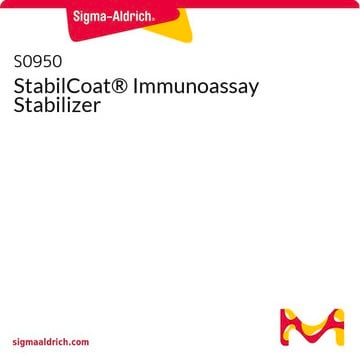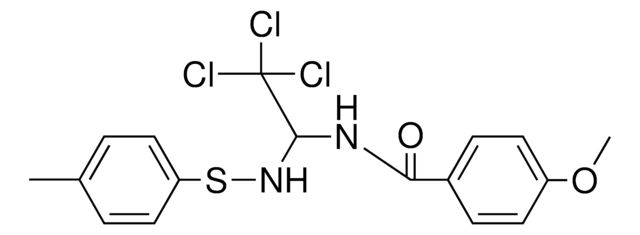Products may be shipped at a different temperature than the recommended long-term storage temperature. If the product quality is sensitive to short-term exposure to conditions other than the recommended long-term storage, it will be shipped on wet or dry-ice. If the product quality is NOT affected by short-term exposure to conditions other than the recommended long-term storage, it will be shipped at ambient temperature. As shipping routes are configured for minimum transit times, shipping at ambient temperature helps control shipping costs for our customers. For more information, please refer to the Storage and Transport Conditions document: https://www.sigmaaldrich.com/deepweb/assets/sigmaaldrich/marketing/global/documents/316/622/storage-transport-conditions-mk.pdf
S2002
Azoture de sodium
ReagentPlus®, ≥99.5%
Synonyme(s) :
Acide hydrazoïque sodium salt
Sélectionner une taille de conditionnement
Sélectionner une taille de conditionnement
About This Item
Produits recommandés
Source biologique
synthetic (inorganic)
Niveau de qualité
Gamme de produits
ReagentPlus®
Essai
≥99.5%
Forme
powder
Conditions de stockage
(Tightly closed. Dry. Keep in a well-ventilated place. Do not store near acids.)
Technique(s)
cell based assay: suitable
immunohistochemistry: suitable
Couleur
white
Pf
370-425 °C
Solubilité
soluble 65 g/L at 20 °C (completely)
Adéquation
suitable for chromatography
suitable for derivatization
Application(s)
sample preparation
Chaîne SMILES
[Na]N=[N+]=[N-]
InChI
1S/N3.Na/c1-3-2;/q-1;+1
Clé InChI
PXIPVTKHYLBLMZ-UHFFFAOYSA-N
Vous recherchez des produits similaires ? Visite Guide de comparaison des produits
Description générale
Application
Réactions catalysées :
Réactif pour la synthèse des composés suivants :
Actions biochimiques/physiologiques
Autres remarques
Informations légales
Gants suggérés pour une protection contre les projections
Produit comparable
Mention d'avertissement
Danger
Mentions de danger
Conseils de prudence
Classification des risques
Acute Tox. 1 Dermal - Acute Tox. 2 Inhalation - Acute Tox. 2 Oral - Aquatic Acute 1 - Aquatic Chronic 1 - STOT RE 2 Oral
Organes cibles
Brain
Risques supp
Code de la classe de stockage
6.1A - Combustible acute toxic Cat. 1 and 2 / very toxic hazardous materials
Classe de danger pour l'eau (WGK)
WGK 2
Point d'éclair (°F)
Not applicable
Point d'éclair (°C)
Not applicable
Faites votre choix parmi les versions les plus récentes :
Déjà en possession de ce produit ?
Retrouvez la documentation relative aux produits que vous avez récemment achetés dans la Bibliothèque de documents.
Les clients ont également consulté
Protocoles
Antibody purification protocols yield preparations containing endogenous IgG alongside specific antibodies.
Detailed ELISA protocols cover indirect and capture ELISA techniques, recommending products for sandwich and indirect ELISA experiments.
-
How is shipping temperature determined? And how is it related to the product storage temperature?
1 answer-
Helpful?
-
-
How can I determine the shelf life / expiration / retest date of this product?
1 answer-
If this product has an expiration or retest date, it will be shown on the Certificate of Analysis (COA, CofA). If there is no retest or expiration date listed on the product's COA, we do not have suitable stability data to determine a shelf life. For these products, the only date on the COA will be the release date; a retest, expiration, or use-by-date will not be displayed.
For all products, we recommend handling per defined conditions as printed in our product literature and website product descriptions. We recommend that products should be routinely inspected by customers to ensure they perform as expected.
For products without retest or expiration dates, our standard warranty of 1 year from the date of shipment is applicable.
For more information, please refer to the Product Dating Information document: https://www.sigmaaldrich.com/deepweb/assets/sigmaaldrich/marketing/global/documents/449/386/product-dating-information-mk.pdfHelpful?
-
-
Can I use this product (S2002) for antibody storage? What is the differences between this idem and S8032-BioXtra or 71289-BioUltra? Thanks,
1 answer-
Product S2002 has not been tested for antibody storage application, the suitability will have to be determined by the end user. Product S8032 and product 71289 are both research grade sodium azide with a quality level 200. Products with a quality level 200 are designed for non-regulated applications with limited change control requirements. The major difference between the two products are the product lines associated with them.
Product S8032 falls into the BioXtra product line. These products consist of stringent testing protocols that may include trace metal analysis and specialized suitability testing, such as hybridoma or mouse embryo culture. This product is suitable for application-specific formulations.
Product 71289 falls into the BioXtra product line. These products consist of the finest quality products for life science with the most stringent testing protocols and highest purity. These products undergo superior manufacturing methods and product specific testing protocols that are designed to ensure quality to the highest standard. The test may include, but are not limited to, purity by gel electrophoresis, trace metal testing, and application testing.
Helpful?
-
-
what do you mean by Bioxtra and reagentplus? How much difference are there between two grades.
1 answer-
Products that fall under the BioXtra portfolio undergo stringent testing protocols that may include trace metal analysis and specialized suitability testing, such as hybridoma or mouse embryo culture. These products include application-specific formulations such as tablets and prepared solutions.
Products that fall under the ReagentPlus portfolio are designed for general laboratory use and have purities that are greater or equal to 95%.
Helpful?
-
-
What concentrations of Product S2002, Sodium azide, are used as a preservative?
1 answer-
Typical concentrations for use are from 0.02 % to 0.1 %.
Helpful?
-
-
How can I determine the concentration of sodium azide in solution?
1 answer-
Sodium azide forms a 3,5-dinitrobenzoyl derivative that can be quantified by liquid chromatography. This method is reported in the Journal of Chromatography, 5, 597 (1982).
Helpful?
-
-
How stable are solutions of Product S2002, Sodium azide?
1 answer-
At a neutral pH sodium azide solutions are fairly stable. Under acidic conditions it is converted to hydrazoic acid, a volatile gas.
Helpful?
-
-
How does Product S2002, Sodium azide, inhibit certain metalloenzymes?
1 answer-
The mechanism of sodium azide inhibition may be due to metal ion complexation and displacement from the enzyme.
Helpful?
-
-
Are there any hazards associated with the disposal of Product S2002, Sodium azide?
1 answer-
Sodium azide can form metal azides. If you have metal pipes for your plumbing, you should not dispose of solutions down them.
Helpful?
-
-
What is the Department of Transportation shipping information for this product?
1 answer-
Transportation information can be found in Section 14 of the product's (M)SDS.To access the shipping information for this material, use the link on the product detail page for the product.
Helpful?
-
Active Filters
Notre équipe de scientifiques dispose d'une expérience dans tous les secteurs de la recherche, notamment en sciences de la vie, science des matériaux, synthèse chimique, chromatographie, analyse et dans de nombreux autres domaines..
Contacter notre Service technique









![[(3R)-3-Hydroxytetradecanoyl]-L-carnitine analytical standard](/deepweb/assets/sigmaaldrich/product/structures/179/609/9ca2d958-e24e-4810-ab06-b5ee692b43b9/640/9ca2d958-e24e-4810-ab06-b5ee692b43b9.png)